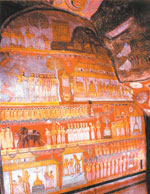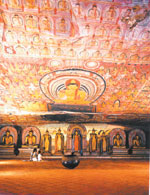|
Gavshaka
moves over to study early Sinhalese paintings As time went on, we see temple walls being decorated with paintings related to the life of the Buddha. Just as much as incidents of the Buddha’s life from birth as Prince Siddartha to the passing away have been described through temple paintings, so are the Jataka tales which relate about the previous lives as a Bodhisatva. Paintings of the Dambulla rock temple have been preserved well possibly because they belong to a much later period. In fact, Dambulla itself is unique in that it has a history dating back to prehistoric times. A series of large boulders, terraces and caves found along the western slopes of Dambulla rock have been identified by archaeologists as habitats of prehistoric man. They have found evidence like stone implements and rock shelters to indicate that there have been human activity.
There are five cave temples in Dambulla covering an internal area of about 1,000 square metres. This is one of the largest complexes of ancient cave or rock-shelter architecture in South Asia. Archaeologist Dr Senaka Bandara-nayake describes Dambulla as the largest, the most dramatic, the best-preserved and the most integrated example of this type of Buddhist vihara in Sri Lanka. In the main vihara known as the Maharaja Vihara, there is a mix of sculpture and painting. Seated, standing and reclining images of the Buddha are found here. The ceiling printings depicting 1,000 Buddhas are not seen anywhere else. The combination of the ceiling paintings and the Buddha images is a rare sight. Another significant feature is the curved rock ceiling of the corridor or ‘sakman maluwa’ adorned by paintings done in the 18th and 19th centuries. The miniature stupa seen in the middle is also something unusual. The principal Buddha image is nearby. The Buddha delivering the first sermon is depicted in the ceiling painting in this central area. Yet another feature of the Dambulla paintings is that they display a variety of style and subject matter. Possibly different
painters belonging to the Kandyan period (when the Sinhalese kingdom
centred round Kandy) had done them at intervals. Not much attention
has been paid on Jataka tales. Apart from incidents related to the
life of the Buddha, the paintings cover scenes from Sri Lankan history
too. Among them are the arrival of Vijaya and the introduction of
Buddhism to Sri Lanka by Arahat Mahinda. |
||||
Copyright © 2001 Wijeya Newspapers
Ltd. All rights reserved. |
 Sigiriya,
as we discussed, occupies a unique place in the history of rock
paintings in Sri Lanka. In several other temples too, there had
been a rich tradition of paintings but most of them have not been
preserved so well. Among the more famous temples with frescoes are
Hindagala (on the Peradeniya-Galaha road) belonging to the 7th century,
Mihintale (8th century), Mahiyangana (11th century), and Dimbulagala
and Polonnaruwa (12th century). Due to the efforts of the Archaeological
Department, frescoes in these temples have been restored to some
extent.
Sigiriya,
as we discussed, occupies a unique place in the history of rock
paintings in Sri Lanka. In several other temples too, there had
been a rich tradition of paintings but most of them have not been
preserved so well. Among the more famous temples with frescoes are
Hindagala (on the Peradeniya-Galaha road) belonging to the 7th century,
Mihintale (8th century), Mahiyangana (11th century), and Dimbulagala
and Polonnaruwa (12th century). Due to the efforts of the Archaeological
Department, frescoes in these temples have been restored to some
extent. In
later history, towards the third century B.C, Dambulla had been
a Buddhist monastery and is considered as one of the largest early
Buddhist monastic settlements in Sri Lanka. Early rock shelters
have been found with drip-ledged caves and inscriptions above them.
In
later history, towards the third century B.C, Dambulla had been
a Buddhist monastery and is considered as one of the largest early
Buddhist monastic settlements in Sri Lanka. Early rock shelters
have been found with drip-ledged caves and inscriptions above them.